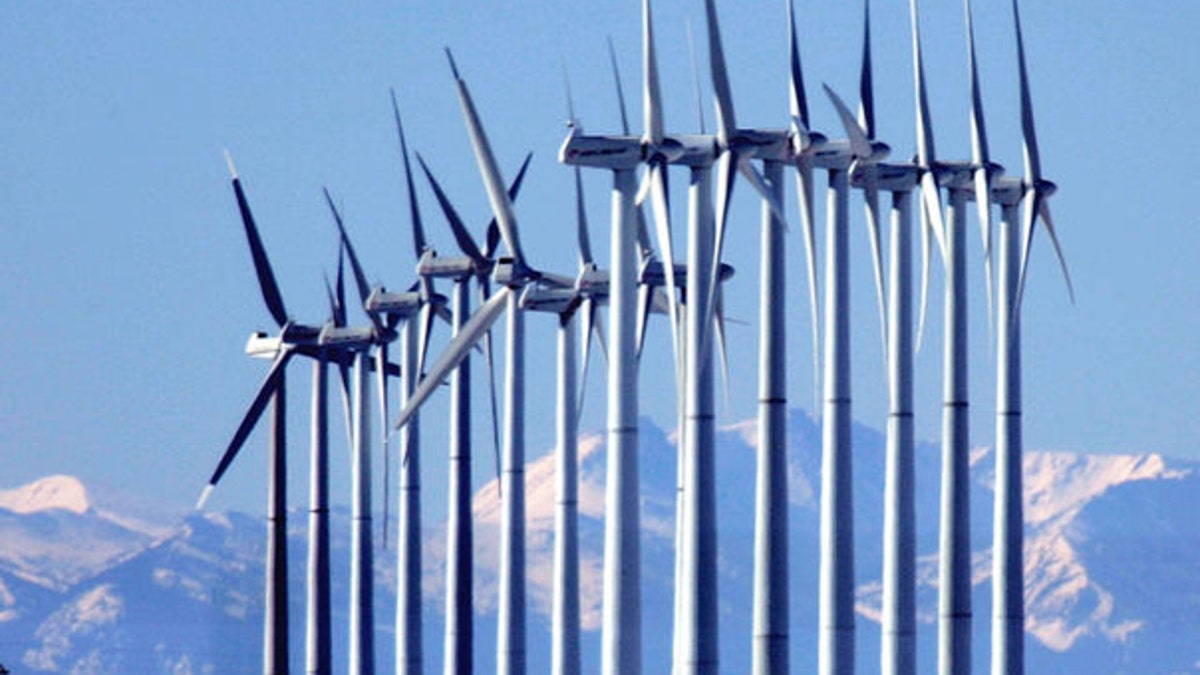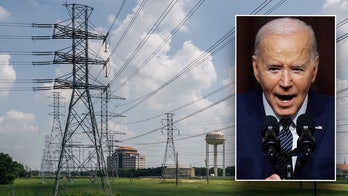
A wind farm in Colorado is shown here. (AP Photo)
One of the nation's leading bird conservation groups plans to sue the Obama administration over a federal regulation that allows wind energy companies to obtain 30-year permits to kill eagles without prosecution by the government.
The American Bird Conservancy on Wednesday announced its intent to file the lawsuit, arguing the Department of the Interior violated federal laws when it promulgated the regulation it says sanctions the killing of bald and golden eagles.
"The rule lacks a firm foundation in scientific justification and was generated without the benefit of a full assessment of its impacts on eagle populations,” said Michael Hutchins, National Coordinator of ABC's Bird Smart Wind Energy Campaign.
The Obama administration announced in December it would allow companies to seek authorization to kill and harm bald and golden eagles for up to 30 years without penalty in a bid to balance the environmental trade-offs of green energy.
The Interior Department rule provides legal protection for the lifespan of wind farms and other projects if companies obtain permits and make efforts to avoid killing protected birds.
Companies must take additional measures if they kill or injure more eagles than they had estimated they would, or if new information suggests that eagle populations are being affected.
In its notice of intent to sue the government, the American Bird Conservancy argues that the rule "undermines the nation’s longstanding commitment to conservation of eagles—unique animals that are ‘ubiquitous in U.S. culture."
The group says the regulation violates the National Environmental Policy Act, the Endangered Species Act, and the Bald and Golden Eagle Protection Act.
"ABC will pursue legal action to address these violations and ensure that eagles, and the millions of Americans who enjoy them, obtain the legal protections to which they are entitled under U.S. law," the organization's notice read.
Matthew Stuber, an eagle permit coordinator with the U.S. Fish and Wildlife Service, told NPR the take permits are an important management tool.
"A permit allows an activity to happen that needs to happen. And in doing so, it gets the best possible thing for the eagles. We’re actually able to get conservation, and hopefully in the long run, prevent that nest from begin disturbed at all by that activity." Stuber said.
Stuber said Fish and Wildlife originally wanted to grant five-year permit but the wind industry pushed for an extended period for more continuity. He said the 30-year permit requires regulators to anticipate problems ahead of time.
“Before we issue a permit, since it’s a lot longer time frame, we need to try to foresee more possible situations and have a better, what we call, adaptive management plan as a part of these permits. That way, when we come in for the five-year check-in, we have things on paper of what we’ll do to respond to certain situations,” he added.
Wind farms are clusters of turbines as tall as 30-story buildings, with spinning rotors as wide as a passenger jet's wingspan. Though the blades appear to move slowly, they can reach speeds of up to 170 mph at the tips, creating tornado-like vortexes.
According to federal biologists, wind farms in 10 states have killed at least 85 eagles since 1997, with most deaths occurring between 2008 and 2012, as the industry was greatly expanding. Most deaths — 79 — were golden eagles that struck wind turbines. One of the eagles counted in the study was electrocuted by a power line.
Wind farms in two states, California and Wyoming, were responsible for 58 deaths, followed by facilities in Oregon, New Mexico, Colorado, Washington, Utah, Texas, Maryland and Iowa.
Hutchins told NPR that the American Bird Conservancy is not against wind energy, but simply wants wind farms to be ordered not disturb or kill eagles.
“It’s just a really big price to pay. I don’t think that we can see these resources as collateral damage to try to win the fight on climate change,” Hutchins said.
The Associated Press contributed to this report.




